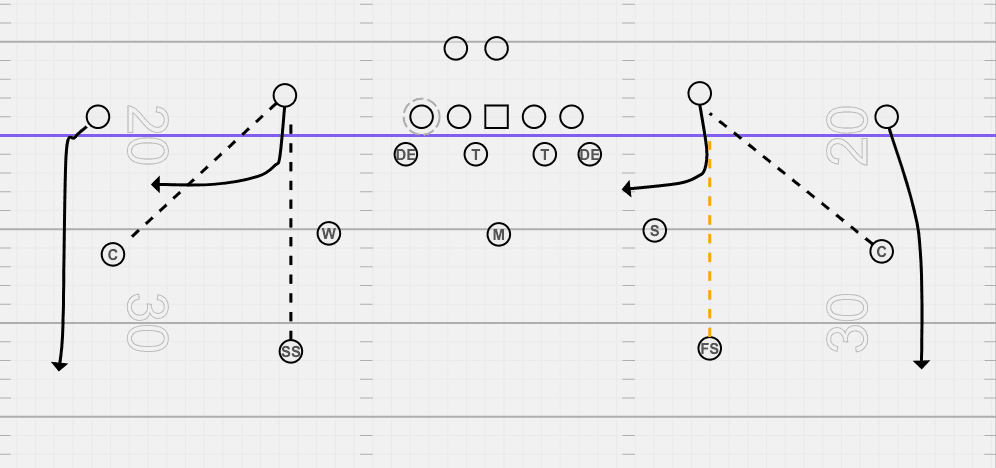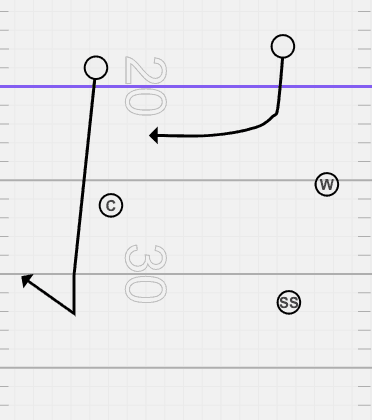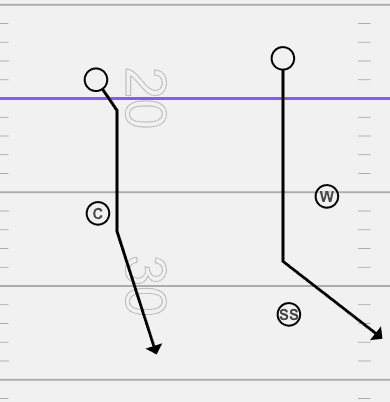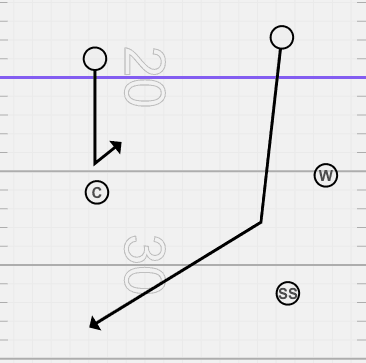Robber coverage has been a staple in defensive coverage from high school to the pro levels. We will go through all the different variations and mindsets behind the robber coverage.
What is robber coverage? Robber coverage, also known as trap coverage, is a defensive coverage similar to cover 2, which baits the quarterback to throw the ball into the flats.
In this article, we’ll show you the ins and outs of robber coverage and why it’s effective.
Why Run Robber Coverage?
As offenses continue to evolve through the RPO, Pin, and Pull, and all the spread concepts, defenses need to come up with ways to trick quarterbacks into thinking a receiver is open when indeed, he is not.
This coverage is different from cover 0 and cover 1; however, it does have some principles of cover 2 and cover 4.
Robber coverage is nothing new; teams have been running it for years. We’re here to break down some simple rules of robber coverage and how you can create your own robber concepts.
Basics Of Robber Coverage
First off, there are a few different names for robber coverage:
- Trap Coverage
- Palms Coverage
- Bait Coverage
- Jump Coverage
We’re going to refer to it as robber coverage throughout this article. It’s always good to keep an open mind, as coaches may use different terminologies in their schemes.
Corner Read In Robber
One of the most simplistic forms of robber coverage is from the corner position.
Let’s break down the diagram above!
The player with the most impact on this play is the corner and the safety. Let’s start with the corner.
Corner’s Rules In Robber Coverage
- In a simple 2×2 formation, the corner is reading the #2 (slot) receiver
- If the second receiver does a bubble or any “out” breaking route, the corner will break toward the receiver
- If the slot receiver does an in-breaking route, the corner will revert to his only threat ( the #1 receiver)
- If the slot receiver goes vertical, the corner will stay deep as well to cover any deep breaking routes
Those are the base rules, as the corner is trying to rob any ball to the flat.
To fully understand the concept, we need to understand how safety plays into the coverage as well.
We’ve drawn two different scenarios in the picture above—one with the receiver breaking inwards and one with the receiver breaking out. Test yourself on what the corner will do on each play.
Safeties Rules In Robber Coverage
- In a 2×2 formation, the safety is also reading the #2 receiver
- If the slot receiver breaks out (the corner will take them), the safety will have to play the #1 receiver
- If the slot receiver break-in, his eyes will work back to the #1 receiver
- If the slot receiver goes vertical, the corner will stay deep, as the receiver will be threatening his zone
This coverage is often run with corners and safeties, quick with both their eyes and feet. Corners who take too long to read or safely get caught flat-footed could get beat over the top by the outside vertical.
If you’re installing robber coverage, we highly recommend classroom time to understand ways to beat it. If you’re not sure how to beat robber coverage, we’ve gathered the most popular combinations to get you started.
Learn How To Watch Film Properly…
Uncover your opponent’s offensive and defensive tendencies so you can easily build a game plan.
Inside You’ll Find:
- Strategies to pick apart defenses
- How to identify player weaknesses
- How to save time in your weekly breakdowns
How To Beat Robber Coverage
As always, we like to teach concepts from both the defensive and offensive sides of the football. If you and your players understand how coverages are beaten, it gives them a better understanding of how offenses try to manipulate them.
If a team runs a fade/out concept, and you can either steal an interception or garner a big hit from it, teams will be alert that it’s some robber coverage. Immediately teams will go into robber-beater mode.
This puts a tremendous amount of stress on your corners and safeties. Let’s dig into some simple 2×2 combinations that could disrupt our robber coverage…
Comeback/Out Combo
With this combination, we’re occupying the corner with the out-route (baiting him to come up and anticipate a throw from the quarterback). Once the corner vacates the area, we want to sneak a comeback about 8-10 yards behind the corner.
Safeties who are reading the #2 receiver will have to get all the way over to the #1 receiver, which is tough to cover with an accurate throw.
This combination can prove useful to quarterbacks with strong arms. The quarterbacks with weaker arms may be a combination you try to throw into the boundary.
Double Post
The double post concept is for teams that can stretch the field vertically or have a slot receiver that can draw some attention. A few things need to happen for this play to be successful.
- The slot receiver needs to get a clean release from the Will. If the Will is playing a catch-collision technique, the slot receiver needs to try to get an inside release to influence the deep safety
- If the wide receiver gets a clean release to the inside, work the leverage and tailor off to the middle of the field to a skinny post
- Another technique is to stem up the corner, break his hips out, then break back to the middle of the field for a clean footrace on the skinny post.
Smash Concept
The smash concept is one of the beginner concepts in every spread system, and for a good reason. It’s an easy, high-low read for the quarterback. If the corner sits on the hitch, throw the corner. If he bails on the corner, throw the hitch. Super simple.
The same concepts apply to the robber/palms concept as well. Knowing the cornerback has to respect the corner route that #2 runs; we stress the Will linebacker to get out to the #1 receiver. If you’re able to couple this with play-action, it forces the Will linebacker to hold the box, giving your quarterback a clear window to throw the football.
Cover 1 Robber Variation
Although we just broke down palms coverage where the corner acts as the robber to any flat routes, there is also a cover 1 variation that is popular in the NFL, college, and high school levels.
Cover 1 robber is when the strong safety rotates to the center of the field, to rob any crossing routes from the opponent.
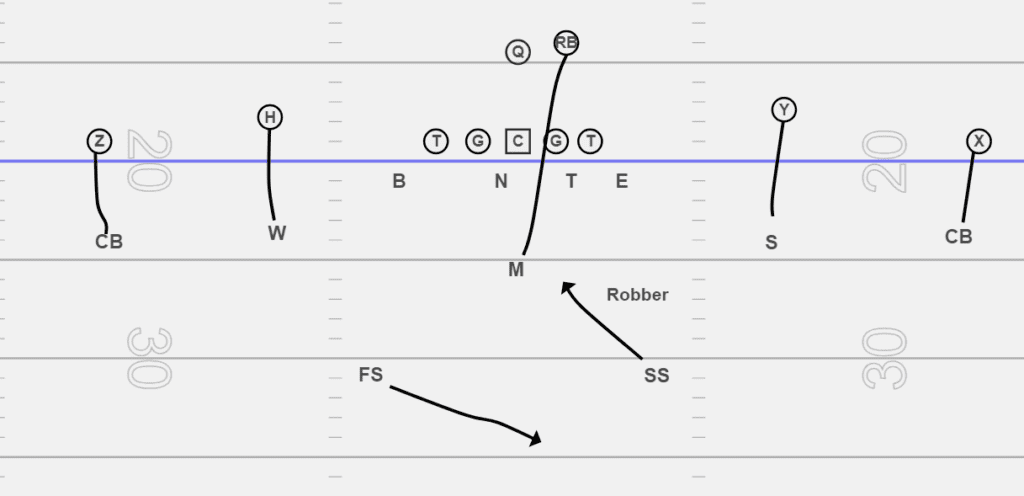
Teams will use robber coverage if the opposing team runs mesh, shallow, or any other crossing patterns, that often result in defensive players being picked.
Cover 1 robber is great to confuse quarterbacks into thinking it’s cover 2 or cover 2 man, before they roll into a different coverage.
Keep Learning
Don’t stop there! Instantly improve your football IQ with our Ultimate Football Guide! Be the smartest in the room after you take this course.
Robber coverage can help you steal an interception from a quarterback who thinks a receiver is open when he’s not. Each coach may have different variations of robber coverage ( especially from the corner or safety position). The one we listed is the most basic and can be implemented against 2×2 or even 2×1 sets to counter teams who love the bubble/flat game.
If you’re looking for alternative coverages, we recommend reading about cover 3 and split field coverages here.
Do you teach palms/robber coverage differently? How many variations of it do you have in your offense? Let us know in the comment section below!

